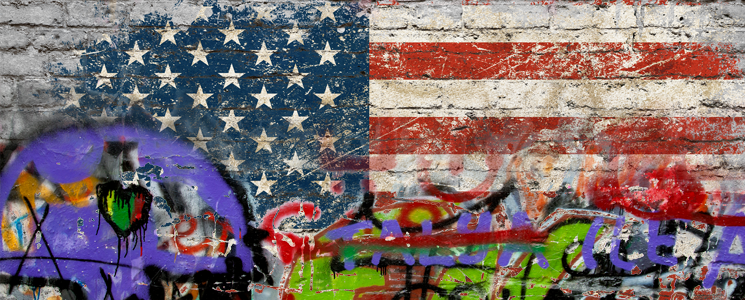On June 1, 2021, Michael McLeer, a New York City-based street artist who goes by “Kaves,” filed a putative class action in the Eastern District of New York against the New York City Police Department (“NYPD”) and the City of New York.[1] McLeer alleges that the NYPD’s graffiti cleanup program violated the Visual Artists Rights Act[2] (“VARA”) and his Constitutional rights to free speech and due process when it painted over a mural he created, entitled “Death From Above.”[3] McLeer proposes a class of other artists whose works are threatened by the NYPD’s recently revived efforts to eradicate graffiti. The heart of his grievance is his allegation that the NYPD is relying upon untrained volunteers, failing to investigate “tips” about graffiti, and systematically failing to confirm with property owners and operators that particular graffiti is unauthorized and unwanted by them and therefore illegal under ordinary criminal and property law principles.[4] While he makes an impassioned defense of street art, McLeer specifically excludes from his suit unauthorized, illegal graffiti,[5] where the question of whether VARA applies remains unsettled.
As covered extensively on this blog, VARA is a United States law protecting certain rights of living artists to preserve the physical integrity of their works of art after sale or installation. In the Second Circuit—where McLeer filed his putative class action—an artist seeking under VARA to protect his or her work from destruction must show that the work at issue has “recognized stature,” that is, both (1) that the work “has ‘stature,’ i.e., is viewed as meritorious,” and (2) “that this stature is ‘recognized’ by art experts, other members of the artistic community, or by some cross-section of society.”[6] To show that his street art has the “recognized stature” required by the statute, McLeer describes in his complaint (i) the general recognition he has received as a street artist,[7] (ii) the specific recognition that his work “Death From Above” has garnered,[8] and (iii) other major pieces of street art he has created.[9] For the prospective class, McLeer describes the importance of street art generally and specifically to New York City, which he alleges benefits enormously from the tourist attention it brings.[10]
There is precedent for applying VARA to street art. As McLeer highlights in his complaint,[11] in a landmark February 2018 ruling, covered on this blog, Judge Frederic Block of the Eastern District of New York awarded $6.75 million in statutory damages to artists of 45 works of aerosol art painted (with the developer’s consent) on the exterior of empty buildings at the “5Pointz” complex, works that the developer later destroyed.[12] In February 2020, the Second Circuit unanimously affirmed Judge Block’s decision and found “nothing in VARA that excludes temporary artwork from attaining recognized stature.”[13] The Supreme Court denied certiorari to the developer’s appeal,[14] leaving the Second Circuit’s decision in place.
Because the NYPD’s graffiti cleanup program is ongoing, the relief McLeer seeks for himself and the proposed class is significantly broader than the monetary damages granted in Judge Block’s “5Pointz” decision, and includes preliminary and permanent injunctive relief against the graffiti cleanup program and public hearings on the NYPD’s graffiti policies.[15] It remains to be seen how the NYPD will defend the implementation of its anti-graffiti initiative. We will continue to monitor how District Judge Carol Bagley Amon balances the interests of street artists in preserving their works with New York City’s goal of removing public graffiti.
[1] See Complaint, McLeer v. New York City Police Department, Civ. No. 2:21-cv-03093 (S.D.N.Y. June 1, 2021) (Dkt. No. 1) (hereinafter “Complaint”).
[2] 17 U.S.C. §106A.
[3] An image of the work is available on Flickr. McLeer attaches to the Complaint an April 10, 2021 Tweet by the NYPD’s 84th Precinct showing a group of men painting over the work.
[4] Complaint ¶ 3.
[5] Complaint ¶ 8.
[6] 17 U.S.C. §106A(a)(3); see Carter v. Helmsley-Spear, Inc., 861 F. Supp. 303, 325 (S.D.N.Y. 1994), aff’d in part, vacated in part, rev’d in part, 71 F.3d 77 (2d Cir. 1995), in which Hughes Hubbard represented the three artist-plaintiffs.
[7] Complaint ¶¶ 20-25.
[8] Complaint ¶ 31.
[9] Complaint ¶¶ 35-36.
[10] Complaint ¶¶ 38-44.
[11] Complaint ¶ 6 n.5.
[12] Cohen v. G & M Realty L.P., 320 F. Supp. 3d 421 (E.D.N.Y. 2018).
[13] Castillo v. G&M Realty L.P., 950 F.3d 155, 167 (2d Cir. 2020).
[14] G & M Realty L.P. v. Castillo, 141 S. Ct. 363 (Mem) (2020).
[15] Complaint at 25-26.


